
I figured it’s been a while since I did a Clash of the Webcomics entry, so here’s a comic strip I remember reading a few times and getting a few laughs out of in my teen years. Then out of curiosity, I decided to revisit it, and oh boy it had changed quite a bit. Today we’re looking at Newshounds, a series created by Thomas K. Dye that had two separate incarnations; a traditional strip and a long-form dramatic novel.
This comic is now complete, running from 1998 to 2014, and many of the themes in Newshounds are still a major part of Dye’s current work. I felt this book had a pretty fascinating evolution, because of just how different both versions feel. Despite the fact it always had an edge of biting satire, to start it’s pretty appropriate for most audiences (think peak Simpsons).
But then, shit gets real. Too real, in fact. To quote Waka Flocka Flame, this comic starts going hard in the paint. I’ve seen comic strips like Funky Winkerbean start out fairly lighthearted and then gradually become more dramatic, but the way Newshounds shifted at points made me go “daaaamn.”
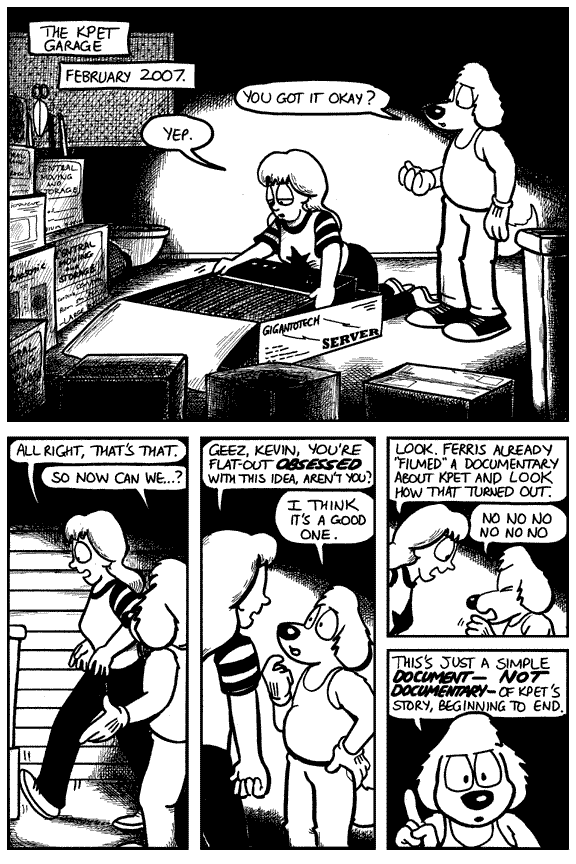
The original series starting in the late 1990s focused on a young woman named Lorna Dilbrook and her pets operating a DIY news studio, and their various misadventures exploring the culture of the times, interacting with eccentric humans, and playing off of each other’s personalities.
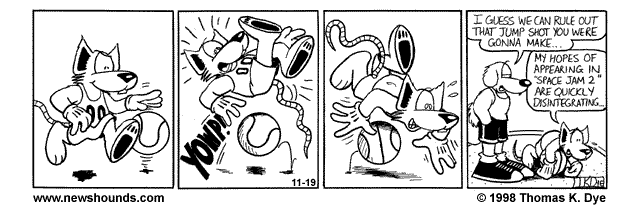
Anchor-pooches Renata Fayre and Wolfram Blitzen were filmed by their golden retriever cameraman Kevin, later joined by the on-scene reporter Rochelle O’Shea, while Lorna’s black lab Sam Shepherd worked as the sports reporter and her cat Alister did the weather. A tacky pop culture-loving rat named Ferris was their janitor, while Della the poodle later came on as the technician.
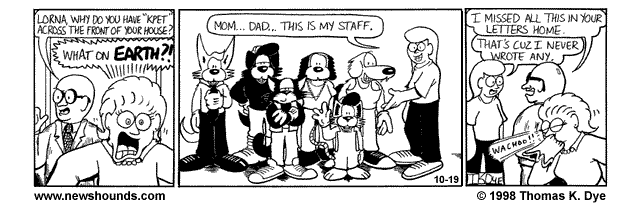
The majority of the first series isn’t too far removed from what’d you’d find in a newspaper comic section. A lot of the 90s and early 2000s content comes off like a wackier version of Doonesbury at points in terms of how topical it is, though I wouldn’t say the messaging has an especially heavy-handed slant to it.
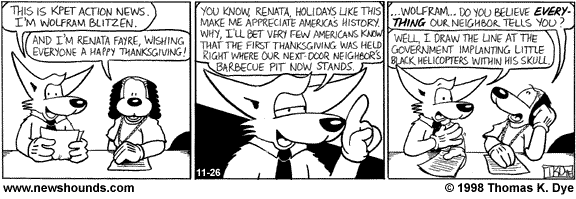
Dye relies a lot on character dynamics for a bulk of his humor, which adds to the variety. He draws a lot of material from Wolfram’s vanity, Ferris geeking over stuff, Kevin’s insecurities, Lorna being eternally just done with everything (she deeply cares for the animals, in spite of her exterior), and Alister’s liberal ideas conflicting with Sam’s conservative beliefs.
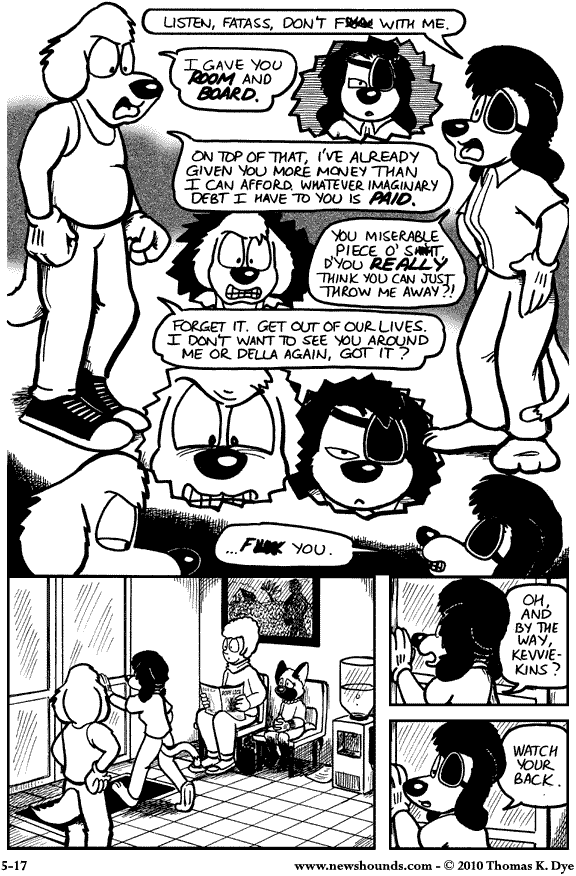
Around 2007 Dye re-launched Newshounds to its more story-based format, and here’s where things get crazy. If the Newshounds graphic novel was an album, it would be titled My Beautiful Dark Twisted Newscast. The relaunch features the cast working at the media conglomerate MegaNewsWest, and their evolving personal lives following their career changes. Kevin falls into a more long-term relationship with his girlfriend Della, but he and his friends have a slew of other problems that prevent the home life from being exactly stable. Sam’s ex-girlfriend Randy is especially a consistent source of ongoing trouble.
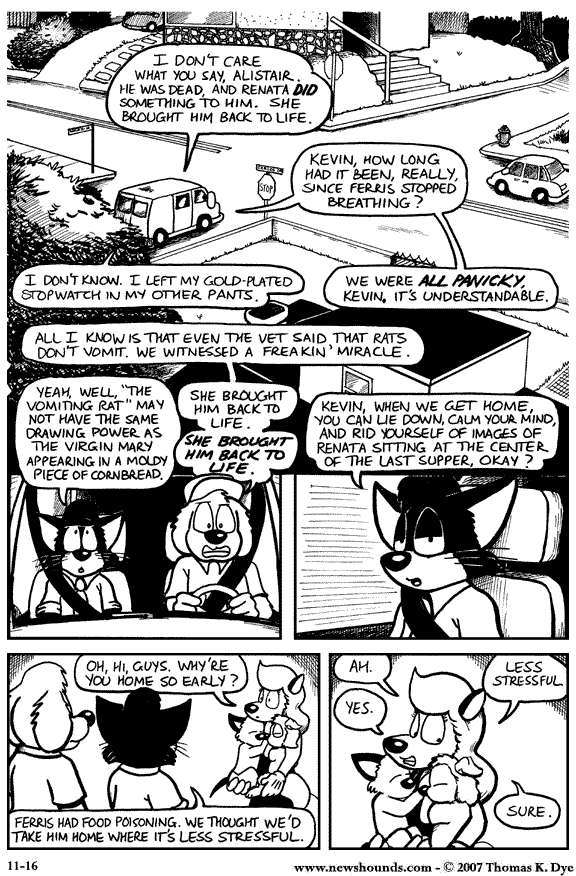
Among other things, Renata’s interest in mental self-help results in her developing psychic powers, putting her in tune with the entire universe (these are themes that Dye puts more emphasis on in Projection Edge). Alistair has a conflict with his boyfriend Nigel regarding what stance their political commentary should take, while Sam gets a new job as the bodyguard for a former child actor-turned-sportscaster at a rival network.
On the lighter end, Ferris is determined to develop a hit script he can sell to a Hollywood producer, but that’s countered by Wolfram being kidnapped and forced into an underground fight ring for stray dogs, and his wife Rochelle’s mission to save him.

Strange enough, this isn’t the first time Wolfram’s been abducted. Dye would sometimes work in longer-running and adventure-themed storylines in the original daily strip, with one arc involving Lorna’s dad getting into serious trouble making me laugh pretty hard. The tone of those was far different than the sequel series though, still maintaining a spoof-ish and lighter atmosphere throughout.
Even though Dye’s art direction is still decidedly cartoony, there’s a clear visual difference from the gag strip in terms of his detailing, shading, and the expressions on his characters. While still retaining his usual wry humor, he shows he can craft narratives with legit dramatic tension and is pretty unapologetic about how far he’s willing to push his content. It’s not just a slight shift, I mean he goes from a mild PG to a hard-R-rating in terms of the subject matter, violence and dialogue.
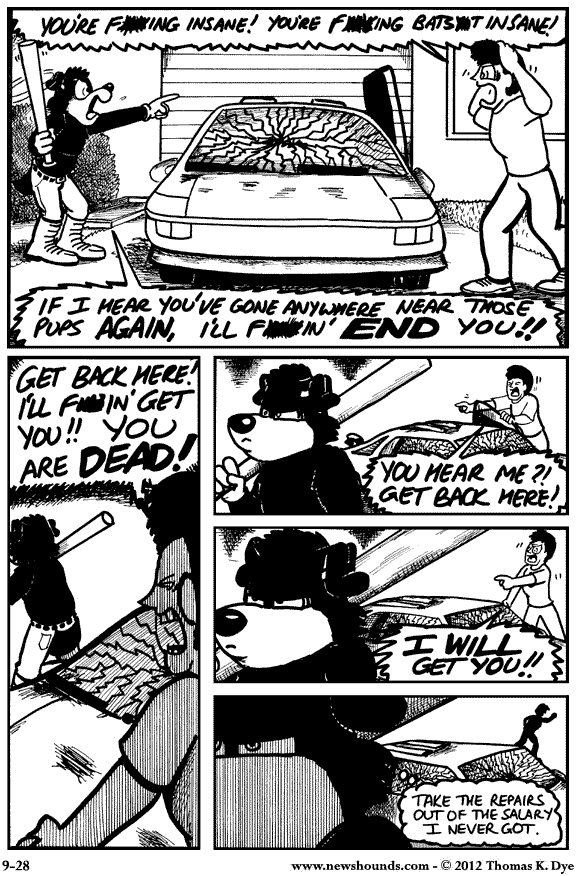
Newshounds II isn’t overly explicit in anything it depicts (the harshest language is blanked out, but barely), but on top of the overall plot becoming far more detailed, this doesn’t stop some of the side storylines in the strip’s later period from feeling actually legit chilling at points. Things like Wolfram’s brutal fight for survival and the angle between Sam and the sportscaster are pretty shocking- to the point where I legit can’t discuss certain plot developments in specific detail here, because it goes to places that might be triggering to some readers.
What helps is that Dye is fully aware he’s evoking Cerebus Syndrome with his characters, and still keeps them likable and affectionate with each other in spite of all the troubles they’re dealing with. He’s got a knack for having each main cast member learn the lesson they need to, and sometimes he’ll display this by drawing out a character’s thoughts in a fantasy dream sequence (showing some nice artistic range on his part).
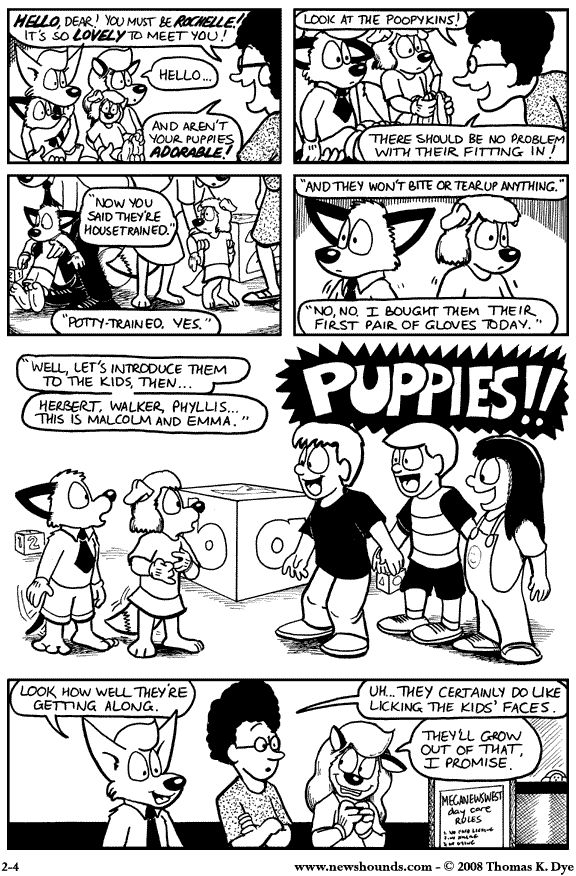
When you’re working on one consistent project over a long period of time. it’s going to evolve with you while you change as a person. Maybe when you’re developing these characters, you think of these what-ifs for them and you can’t help but put it out there, and I think that’s what happened with Newshounds. In both versions, there’s a lot to unpack- each for its own reasons.
Dye made a cartoon once wondering how dark his animal material was compared to Beastars- and having also watched that, I think it’s apples and oranges. First off, I think they’re both well-made. But Newshounds is different from Beastars because that manga started out with a dramatic atmosphere from day one, and Dye’s strip did such a tonal 180*.
Still, Newshounds is a comic that’s willing to take a lot of risks with its cast, so I will easily give it credit for that, and I certainly see why it was so popular over its run. At first, you want to say to the cast “Who’s a good broadcast journalist? Yes, you are! Yes, you!” Then it just loses its mind (in a fun way), the book literally goes into another reality (at multiple points). If nothing else, none of the developments are ever boring.
If you’re interested in checking it out or perhaps Dye’s current Projection Edge series, you can find it here!
